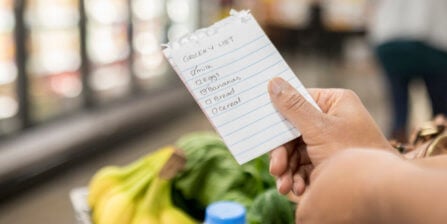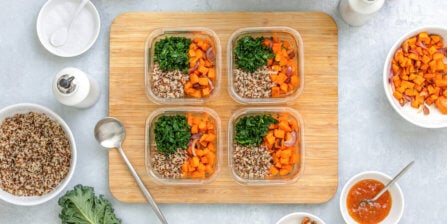Planning & Prep
How to Grocery Shop on a Budget: 8 Tips & Tricks

Many factors can contribute to an individual’s grocery shopping habits. These factors include marital status, family size, lifestyle choices, work schedule, free time, and food preferences, and they play a part in your grocery spending. Anyone can spend too much on groceries without proper planning. So if you’re looking for ways to cut back on your grocery bill, keep reading to find our best tips and tricks for how to grocery shop on a budget.
Quick Answer
How do you grocery shop on a budget?
The best way to save money while grocery shopping is to create a reasonable budget beforehand and stick to it. You can calculate your budget by taking into account your family size, dietary restrictions, lifestyle, and meal plans. Additional cost-saving tips include buying in bulk, using coupons, purchasing non-perishables, and ordering online.
Creating a grocery shopping budget
To start saving money, you’ll first need to come up with a plan for budgeting groceries. One way to get started involves following the 50/30/20 rule: 50% of your monthly income should be devoted to “needs” or essentials, 30% should go toward “wants” like luxury items or fun experiences, and 20% should be put toward financial goals like debt repayment and savings. Along with many other essential purchases, groceries would belong to the 50% category. However, you’ll want to tally up your other essential purchases to figure out how much wiggle room is left within this category for spending on groceries.
Make sure to use Instacart’s grocery budget calculator to get a clear estimate of exactly how much you should be spending on your food needs. The calculator takes into account your family size, shopping preferences, and lifestyle to determine a reasonable budget based on the current USDA guidelines.
Next, keep track of what you’re currently spending on groceries. To do this, you can keep your receipts, look back at your credit card history, use a budget tracking app, or write down how much you spend each trip to the grocery store. To get a good picture of your spending habits, keep track of how much each item purchased costs and how essential that item is to your dietary needs. Once you’ve done this, consider how close you are currently to hitting that target budget. You’ll need to get creative with your spending habits to bring it down to your target goal if you’re over.
Tips for grocery shopping on a budget

1. Plan your meals and shopping list
An easy way to lose track of your spending is by going grocery shopping without a plan. Random trips to the grocery store mean making food choice decisions in the moment, often leading to unnecessary purchases. To better track your spending, prepare a shopping list in advance and stick to it while in the store. This will help you plan your spending for each trip and save you time inside the store. A great way to structure your shopping list is by preparing your meals for the week. Once you know what each meal will consist of, you can check your pantry for ingredients you already have and put any remaining ingredients on your list.
2. Consider purchasing non-perishable items
To make your purchases last, consider buying non-perishable items when you can. The long shelf lives of non-perishable items mean that you can make them stretch over the course of weeks or months before eating them. Typically, non-perishable items will last months to years in your pantry or refrigerator before meeting their expiration dates.
3. Strategically purchase perishable items
An easy way to lose money is by buying too many perishable items that end up going unused. Fresh produce, fruits, and vegetables, or milk and cheese left for too long will go bad before you get a chance to use them. To get the most out of your purchase, buy only those perishable items that you’re sure you’ll use in time. If buying more than this amount, consider freezing these items to make them last longer.
4. Consider buying in bulk
As a general rule, non-perishable items packaged in bulk typically come at a lower price overall. This is because more packaging and processing typically means a higher price tag. Consider buying your items in bulk, but be sure to do the math first, as not all bulk items will save you money.

5. Consider generic brands
Brand-name foods and consumer goods typically come with a higher price tag. However, generic alternatives are an excellent option for shoppers looking to save money and provide the same great flavor that you’re looking for.
6. Use coupons strategically
Use these resources strategically if you clip coupons from the local paper or receive coupons directly from your grocery store. You’ll likely receive coupons for items that you don’t typically use or don’t necessarily want. While saving money on these items may be tempting, ask yourself whether you’ll actually use the item. If it’s unlikely, don’t give in to the temptation to use the coupon. You may also want to check out the current deals from our retailers.
7. Don’t grocery shop when you’re hungry
Just like shopping without a plan or grocery list, shopping with an empty stomach can lead to excessive and unnecessary purchases. When you’re hungry, you’re more likely to buy more than you need. As soon as the hunger is gone, you’ll be left with extra groceries that may go unused and a hefty grocery bill.
8. Order your groceries online for curbside pickup or delivery
A great way to apply many of the tips mentioned above is by ordering your groceries online. You can more easily stick to your grocery list by ordering online and avoid purchasing tempting items you would otherwise see in the store. Ordering online allows you to quickly compare prices at different locations, selecting those that meet your budget. Once you’ve added each item on your list to your online shopping cart, you can immediately see your balance and make adjustments accordingly.

Resources related to grocery shopping on a budget
If you found this guide on how to shop for groceries on a budget helpful, make sure to check out our related resources:
- Essential Foods for a Vegan Grocery List on a Budget
- Easy & Satisfying Meal Prep Ideas
- Step By Step Guide: How to Plan Meals for the Week
Meet your grocery shopping spending goals with Instacart
Now that you know how to save money on groceries, it’s time to get shopping. With Instacart, you can compare prices across many grocers, stick to your shopping list, and avoid unnecessary purchases. Select the items you need, and choose a delivery or pick-up option that works best with your schedule!
Most Recent in Planning & Prep

Planning & Prep
37 Care Package Ideas: From “Get Well” to “Just Because”
It’s always nice to show some extra appreciation for your loved ones. Whether you want to support a sick friend or a neighbor who had their first child, a care package is the perfect way…
Jan 30, 2025
Planning & Prep
Average Grocery Cost per Month: The 2025 Breakdown
The average grocery cost per month, per person, in the United States is roughly $350 for adults between 19 and 50 years old in a four-person household. This estimation depends on multiple factors, such as…
Dec 23, 2024
Planning & Prep
33 Shocking Global and National Food Waste Statistics (2025)
Did you know nearly 30% of the food produced globally is never eaten? This staggering food waste statistic highlights the alarming issue of uneaten food — a problem with environmental, economic and social consequences. Food…
Dec 23, 2024

 17 Grocery List Categories to Make Shopping Easy
17 Grocery List Categories to Make Shopping Easy  How to Meal Plan: Step-by-Step Guide to Meal Planning
How to Meal Plan: Step-by-Step Guide to Meal Planning  How To Read Food Labels: Guide to Nutrition Labels
How To Read Food Labels: Guide to Nutrition Labels 

